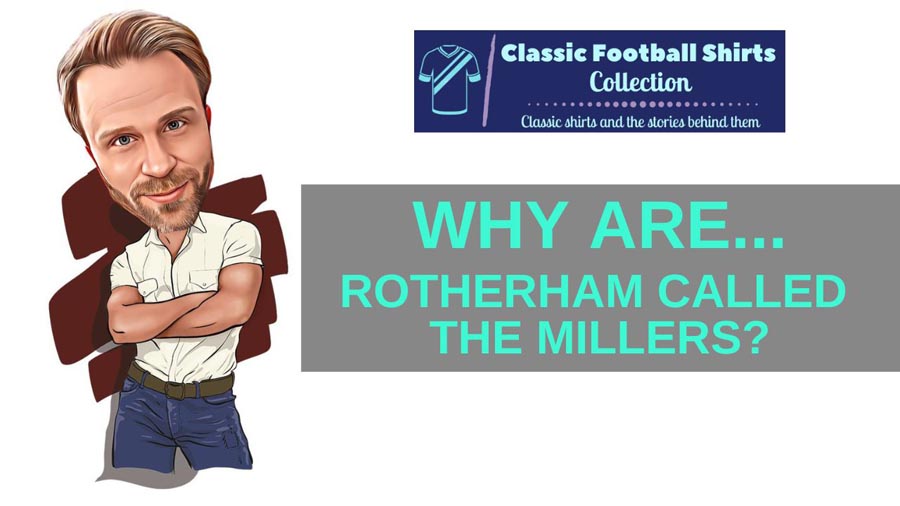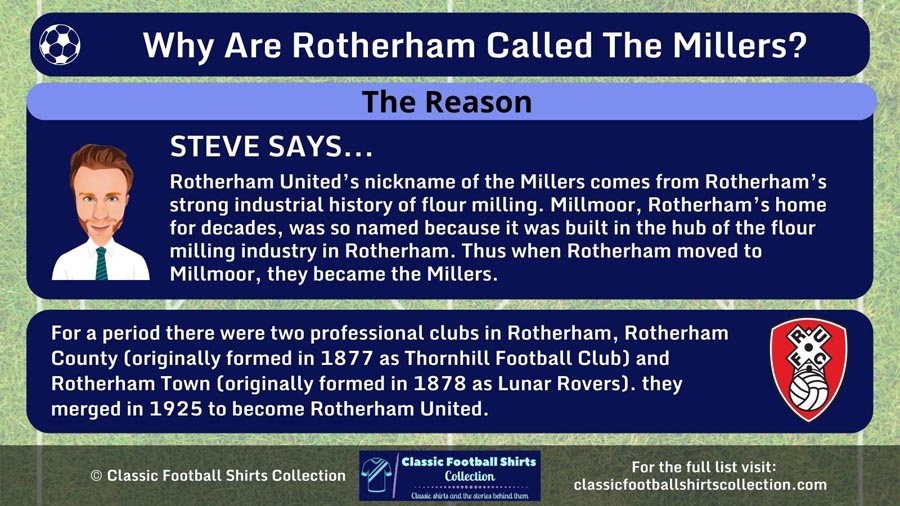
I worked in Rotherham for a year after finishing university in Sheffield in 2000.
At the time Rotherham were definitely on the up under the stewardship of Ronnie Moore.
When I left Sheffield and my job in Rotherham to return home to Kent in 2001, they had just been promoted to the second tier of English football.
It was a considerable achievement for the Millers.
But why are Rotherham called the Millers?
Let’s take a closer look…
Why Are Rotherham Called The Millers?
Rotherham United’s nickname of the Millers comes from Rotherham’s strong industrial history of flour milling. Millmoor, Rotherham’s home for decades, was so named because it was built in the hub of the flour milling industry in Rotherham. Thus when Rotherham moved to Millmoor, they became the Millers.

Rotherham’s Industrial Heritage
In contrast to the stories behind some clubs’ nicknames, Rotherham’s nickname of the Millers is actually pretty straightforward.
During the industrial revolution the main industry in Rotherham was flour milling. This industry was still thriving at the end of the 19th and beginning of the 20th century when the football club was founded.
The industry in Rotherham centered around the area where the football stadium Rotherham would play in for over a century was built in the 1890s.
In fact, the association between the area and flour milling gave the stadium its name, Millmoor.
And this in turn gave Rotherham United its nickname, they were the Millers who played at Millmoor.
Rotherham’s United, Town and County…
RELATED ===> Why Are Brentford Called The Bees?
Although formed as a result of merger between Rotherham County and Rotherham Town in 1925, Rotherham United’s history goes back much further than that.
In 1877 Thornhill Football Club was founded in Rotherham, and played in the Sheffield and Hallamshire League.
The main team in Rotherham at this time however was Rotherham Town.
They were founded in 1878, a year after Thornhill, as Lunar Rovers.
By 1893 however, whilst Thornhill were still playing in the Sheffield and Hallamshire League, Rotherham Town were elected to the Second Division of the Football League.
The club’s spell in the Football League was shortlived. Three seasons to be exact. They folded at the end of the 1895/96 season.
Rotherham Town reformed and entered the Sheffield Association League in 1899, but their brief spell out of existence meant by then Thornhill United has usurped them as the main team in the area.
In 1905, in recognition of this, Thornhill United changed its name to Rotherham County.
For the next twenty years, Rotherham Town and Rotherham County competed separately and with considerable success.
In fact in 1911/12, the two teams finished first and second in the Midland League.
In 1919 Rotherham County were elected to the Second Division of the Football League, whilst Rotherham Town continued in the Midland League.
As is the topsy-turvy nature of football, by 1925 it was Rotherham County whose fortunes had declined as they sought re-election to the football league.
RELATED ===> Why Are Luton Town Called The Hatters?
At this time it became obvious that having two professional football teams in a moderately sized town was not sustainable.
In May 1925 Rotherham Town and Rotherham County merged to become Rotherham United.
So to recap:
| Thornhill Football Club | Rotherham Town | |
| 1877 | Formed | |
| 1878 | Formed (as Lunar Rovers) | |
| 1893 | Playing in Sheffield and Hallamshire League | Elected to Football League |
| 1896 | Team folds | |
| 1899 | Team reforms | |
| 1905 | Becomes Rotherham County | |
| 1919 | Elected to Football League | |
| 1925 | Merge to become Rotherham United | Merge to become Rotherham United |
A Brief History of Rotherham United
Millmoor was Rotherham United’s home until 2008.
Perhaps the high point in the history of the club (and stadium) came from 1951 to 1968, when Rotherham enjoyed an unbroken run of 17 seasons in the second tier of English football.
In fact, in seven of those seasons they finished in the top 10, and in 1954/55 they came agonisingly close to winning promotion to the top flight of English football.
That season Rotherham started the campaign with six wins from their first seven games to put them top of the table.
However they followed that up with five defeats in their next nine games, and for most of the season it looked unlikely they would improve on their excellent 5th-placed finish the previous season.
But then on 8 April 1955, they started a run that saw them win eight of their last nine games.
This run included a 6-1 victory against Liverpool on the final day of the season.
RELATED ===> Why Are Bournemouth Called The Cherries?
The only blot on the club’s copybook in that time was a 1-0 defeat to Port Vale, who were to finish that season in 17th place.
That defeat proved costly because Rotherham finished level on points with Birmingham City and Luton Town.
However by virtue of their inferior goal average Rotherham were consigned to 3rd place with Birmingham and Luton taking the promotion places.
It was to be the closest they have ever come to reaching the pinnacle of English football.
It was during the club’s prolonged stay in the Second Division that they also reached the final of the inaugural League Cup.
Again they were so close to a memorable victory in the two-legged Final.
They beat Aston Villa 2-0 at Millmoor only to lose 3-0 to at Villa Park.
In May 2008 Rotherham left Millmoor after talks with the owner of the stadium broke down.
They played at the Don Valley Stadium for a few seasons, before moving into the 12,000-capacity New York Stadium in 2012.
Although they no longer play at Millmoor, Rotherham United are still known as the Millers.
Final Thoughts

Rotherham United’s nickname of the Millers is derived from the stadium they played in for many years, Millmoor.
Millmoor in turn took its name from the main industry in Rotherham of flour milling which was centred in the area where the stadium was built.
So the nickname of Rotherham United Football Club is linked to the strong industrial heritage of history of flour milling in the area.
Sadly despite living in Sheffield for four years and working in Rotherham for a year (RIP Lombard North Central on Moorgate), I never went to Millmoor.
